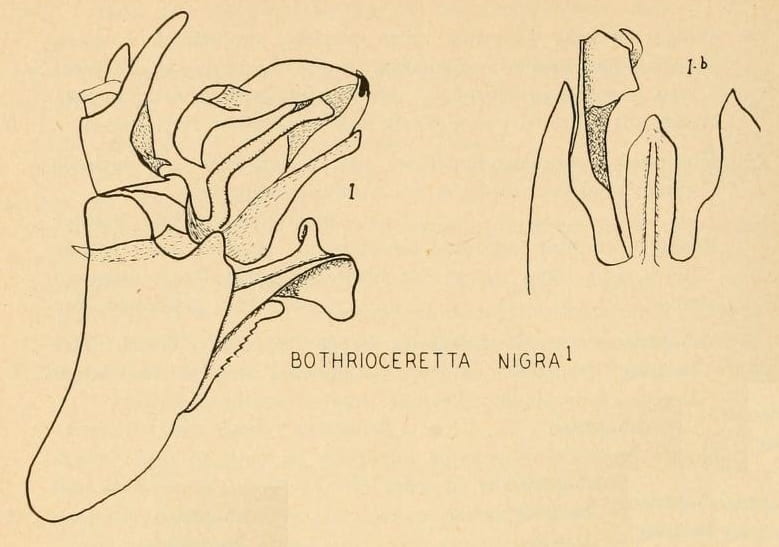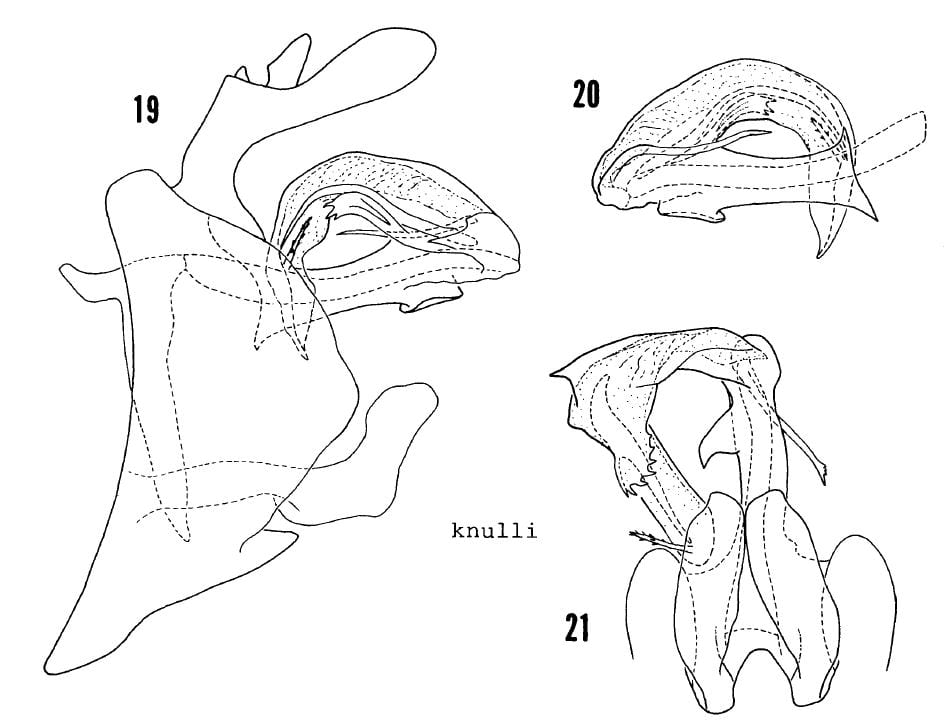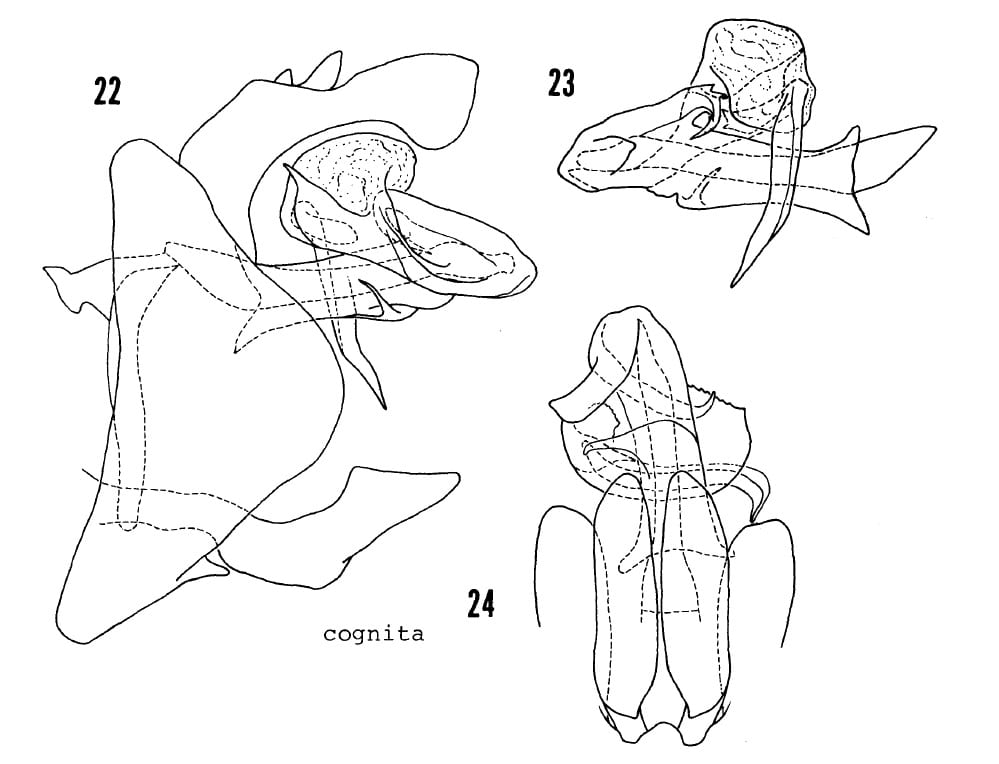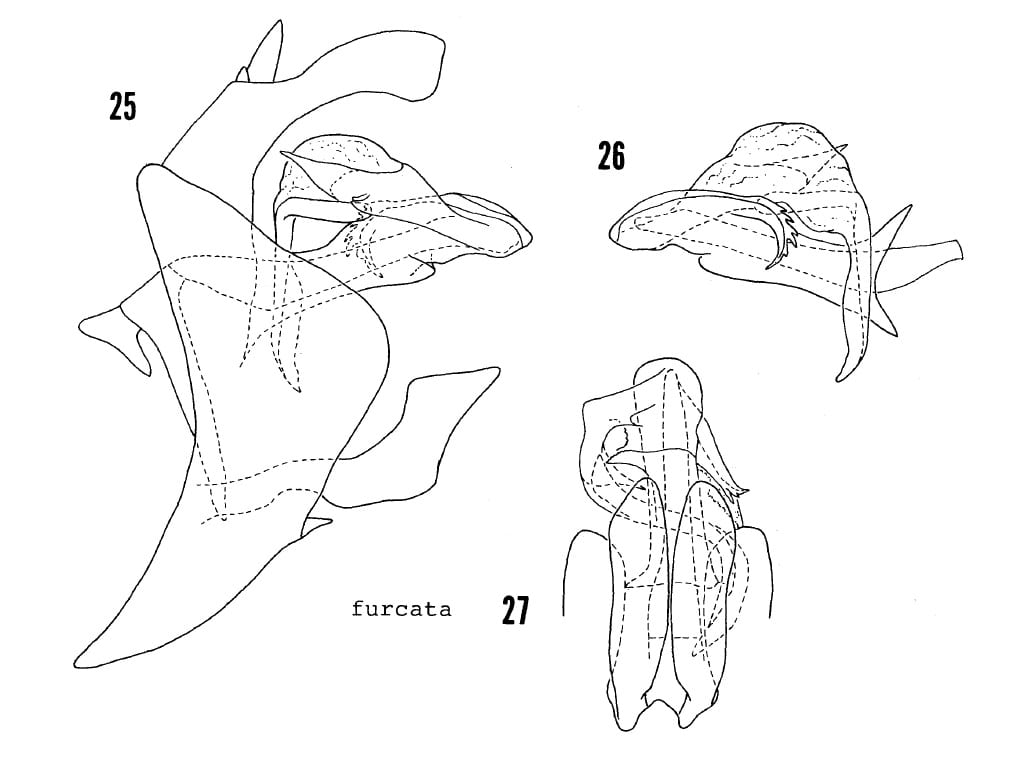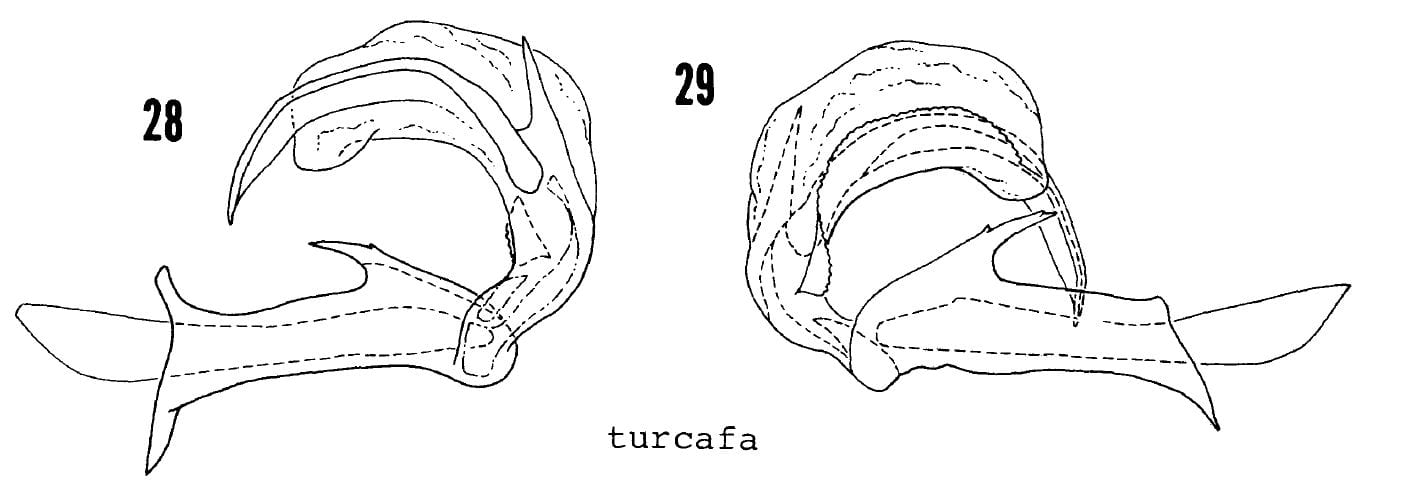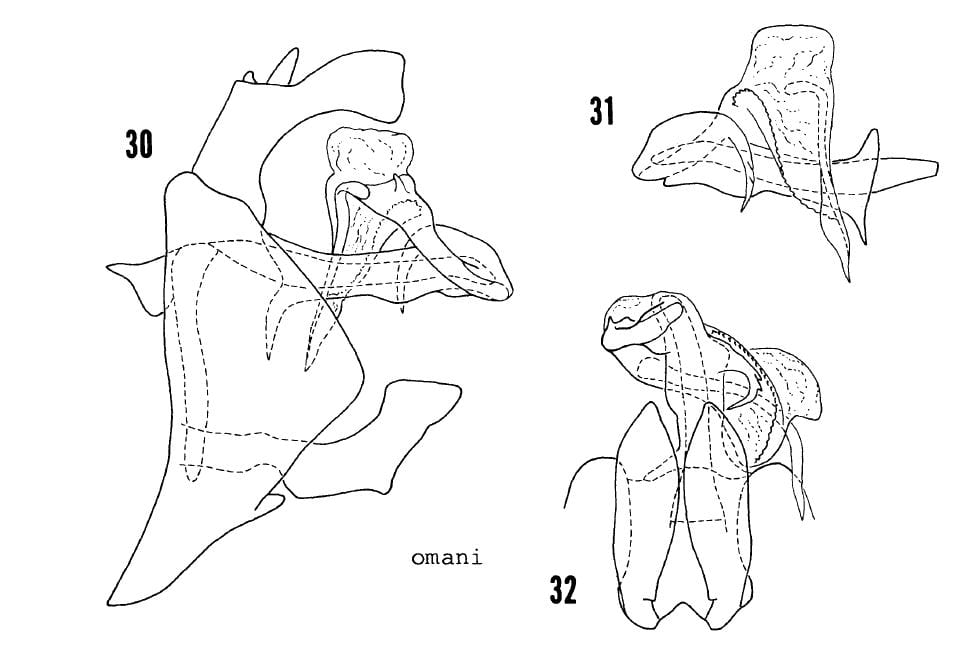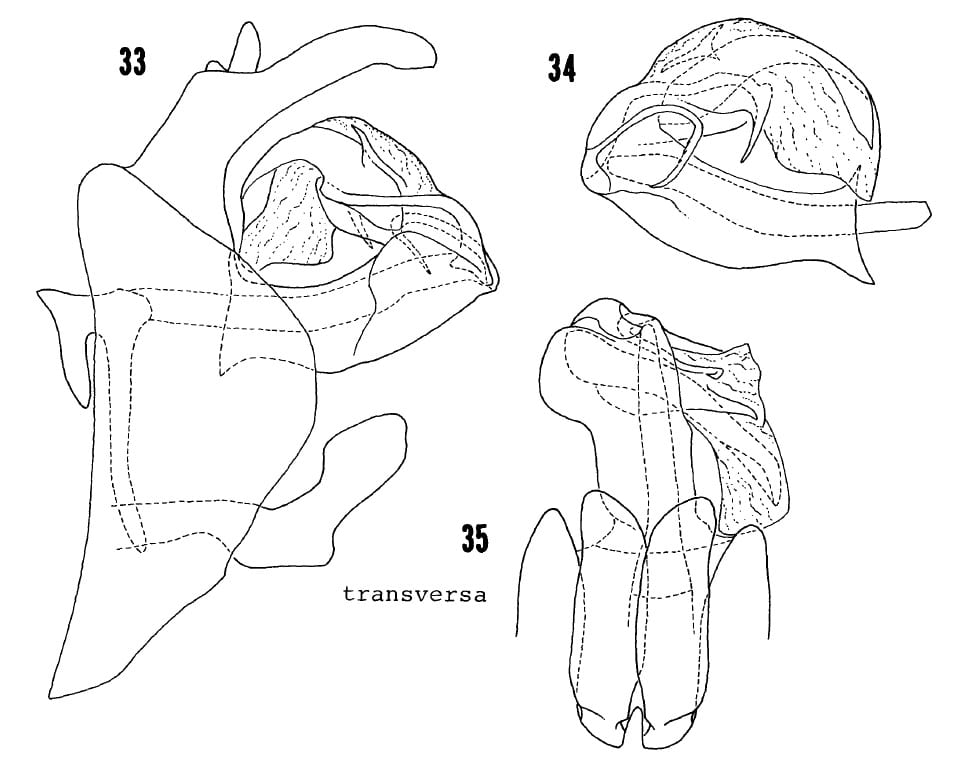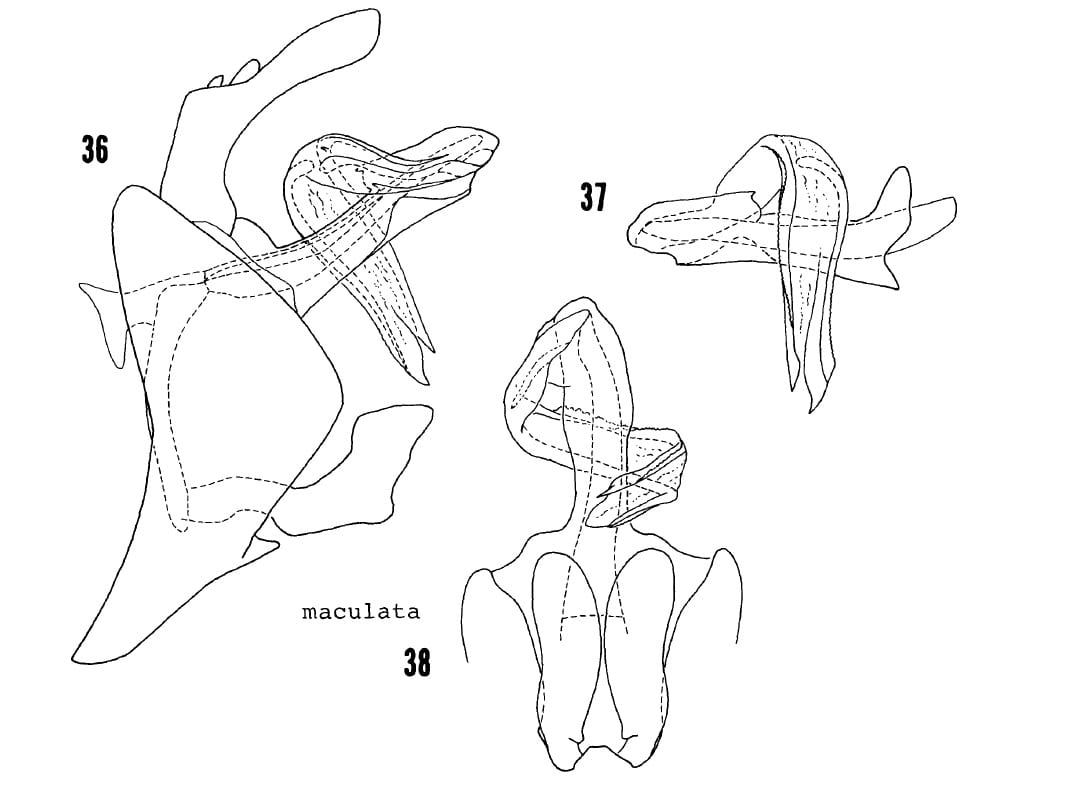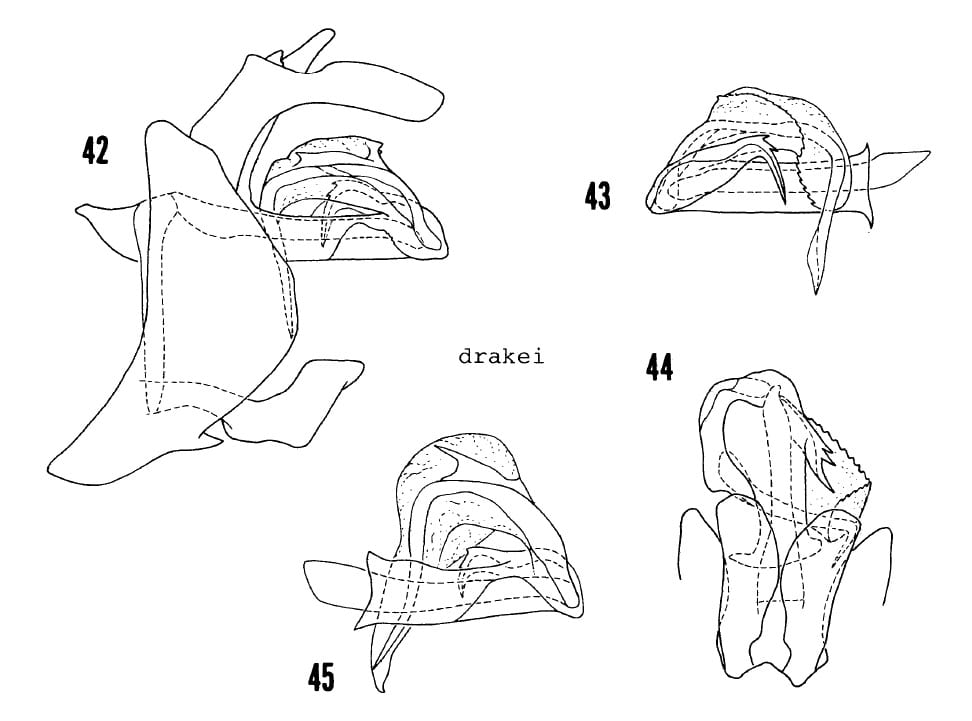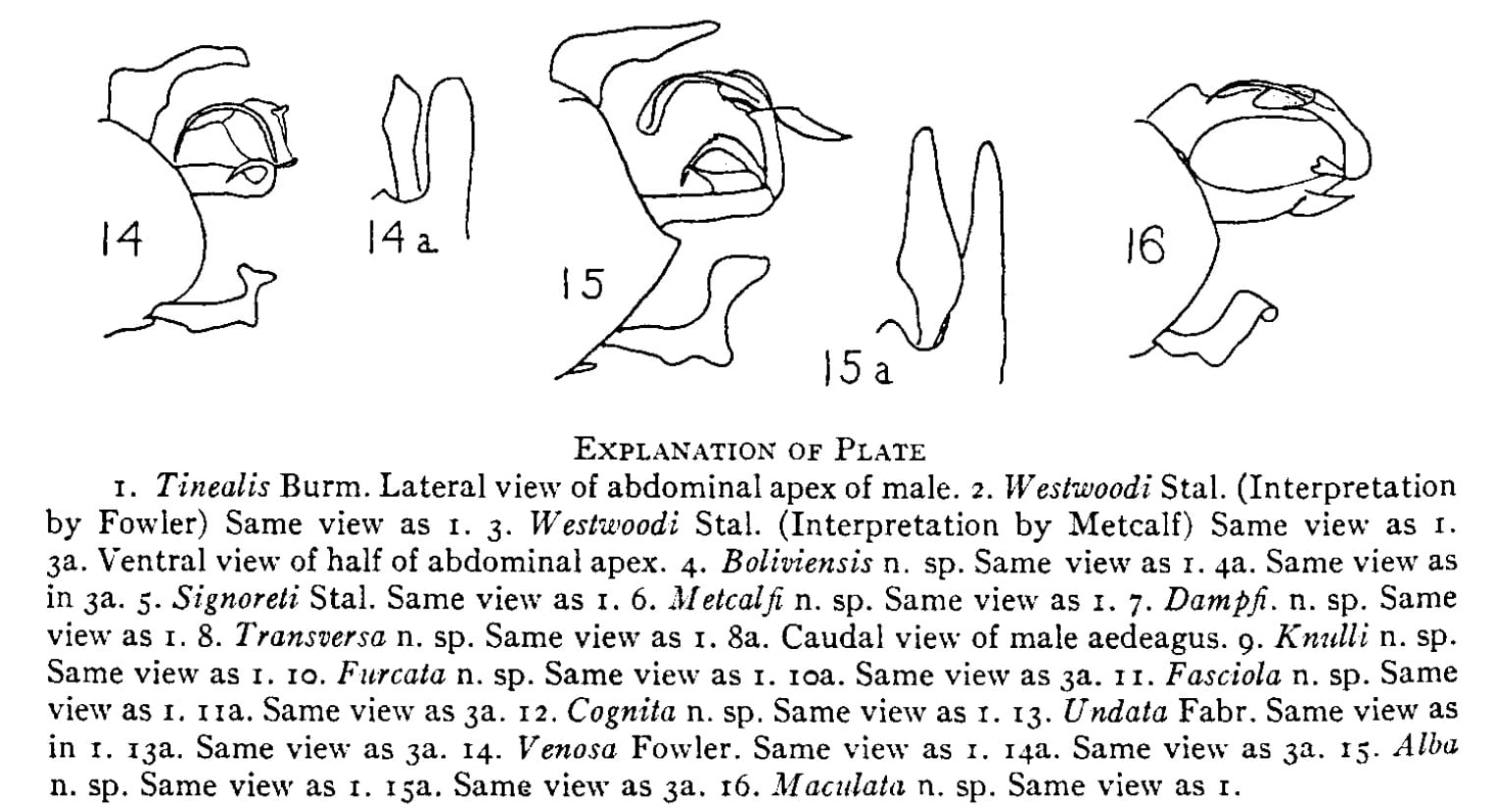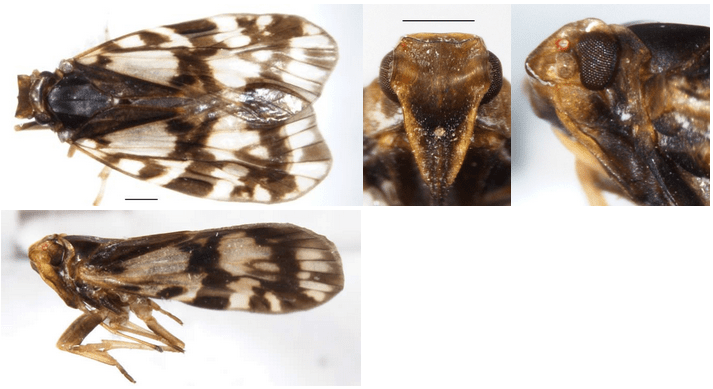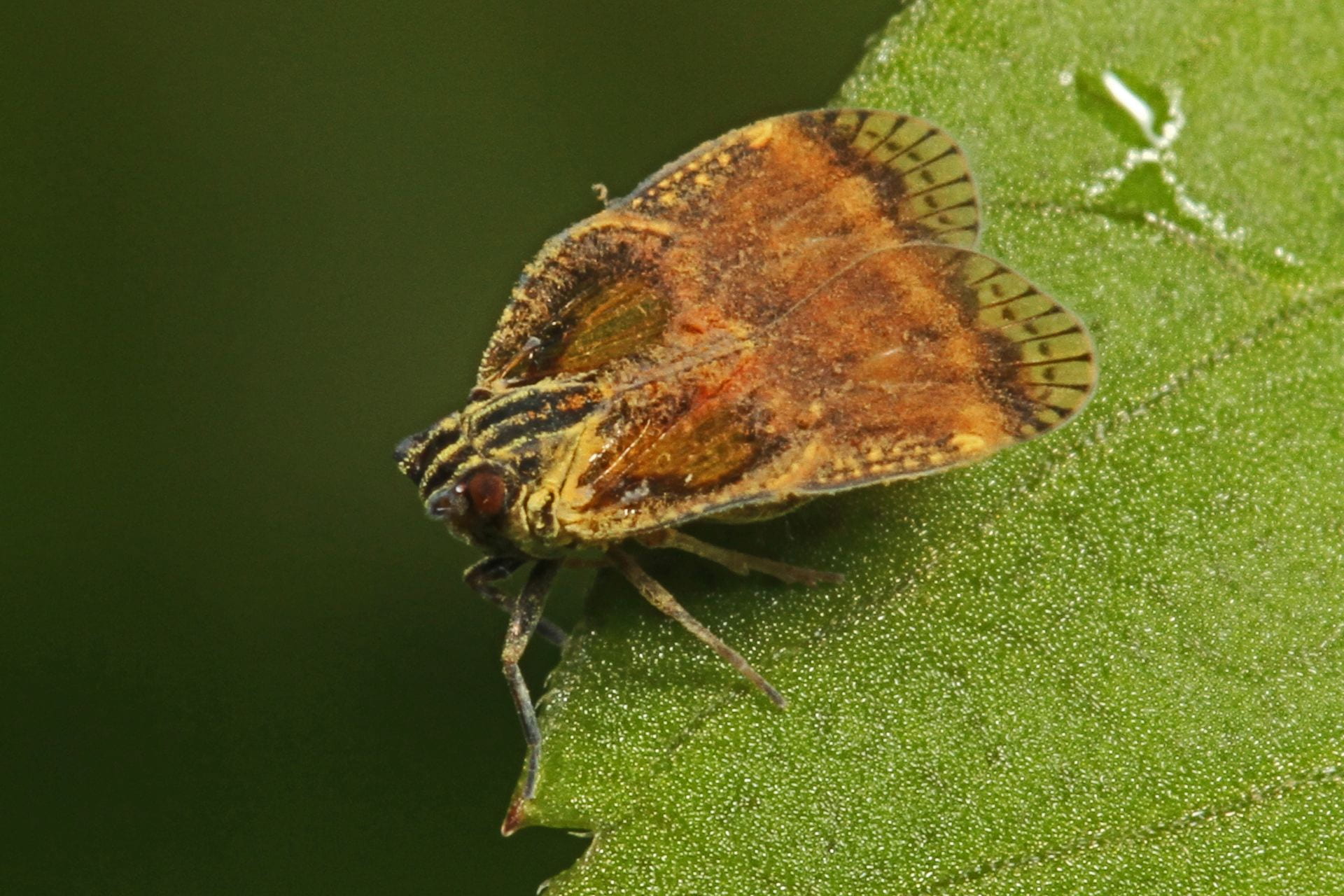[Back to North American Cixiidae]
Contents
- 1 Family Cixiidae Spinola, 1839
- 1.1 Subfamily Bothriocerinae Muir, 1923
- 1.2 Tribe Bothriocerini Muir, 1923
- 1.3 Genus: Bothriocera Burmeister, 1835: 156.
- 1.4 Distribution
- 1.5 Recognized species
- 1.6 Economic Importance
- 1.7 Plant associations
- 1.8 Recognition
- 1.9 Online Resources
- 1.10 Collecting
- 1.11 Molecular resources
- 1.12 Selected references
Family Cixiidae Spinola, 1839
Subfamily Bothriocerinae Muir, 1923
Tribe Bothriocerini Muir, 1923
Genus: Bothriocera Burmeister, 1835: 156.
Type species: Bothriocera tinealis Burmeister, 1835.
Synonyms
Adana Stål, 1856 (Type species Adana westwoodi Stål, 1856); syn. by Stål 1864a: 50 (moved to Bothriocera); see also Fowler 1904: 82 (conspecific with Bothriocera tinealis, but subsequently, e.g., by Kramer).
Distribution
Widespread in New World, especially in the tropics

Distribution of Bothriocera from TaxonPages (World Auchenorrhyncha Database)
Recognized species
There are 46 species as follows [Metcalf catalog]
Bothriocera alba Caldwell, 1943 – Bolivia
Bothriocera albidipennis (Fowler, 1904) – See Bothrioceretta
Bothriocera aurea Bahder & Bartlett, 2025 – Costa Rica
Bothriocera basalis Metcalf, 1938 – Panama, Mexico (San Luis Potosi, Oaxaco)
Bothriocera bicornis (Fabricius, 1803) – Brazil, Trinidad (reported in error: USA: MD, FL, MS, NC, NJ, TX, NC, MS, FL; Cuba, Puerto Rico, St. Vincent)
Bothriocera boliviensis Caldwell, 1943 – Bolivia
Bothriocera caca Fennah, 1971 – Grand Cayman
Bothriocera cognita Caldwell, 1943 – USA: AL, DE, FL, IL, MD, MO, MS, NJ, OK, PA, TX, VA
Bothriocera cotiso Fennah, 1971 – Jamaica
Bothriocera cyanea Fennah, 1943 – Dominica
Bothriocera daedala Fennah, 1943 – Dominica
Bothriocera dampfi Caldwell, 1943 – Mexico (Chiapas, Veracruz)
Bothriocera datuna Kramer, 1983 USA: AL, FL, LA, TX
Bothriocera diploneura Fennah, 1971 – Cuba
Bothriocera drakei Metcalf, 1923 – USA: DE, FL, IL, LA, MD, NC, NY, OH
= Bothriocera tinealis floridana Dozier, 1928: 56; syn. by Kramer 1983: 26.
Bothriocera eborea Fennah, 1943 – St. Kitts, St. Lucia, Dominica, Montserrat, St. Vincent, Nevis, Martinique, Tortola, Jost Van Dyke, etc.
Bothriocera emeljanovi O’Brien, 2006 – Dominican Republic
Bothriocera excelsa Fowler, 1904: 83 – See Bothrioceretta
Bothriocera fasciola Caldwell, 1943 – Mexico (Oaxaca), Honduras
= Bothriocera ferruginea Fennah, 1971 – Haiti
Bothriocera furcata Caldwell, 1943 – USA: FL, GA, MS, VA
Bothriocera haitiana Fennah, 1971 – Haiti
Bothriocera harthi Bahder & Bartlett, 2023 – Jamaica
Bothriocera hastata Fennah, 1943 – St. Vincent
Bothriocera hispaniolae Caldwell, 1950 – Dominican Republic
Bothriocera holzingeri O’Brien, 2006 – Panama
Bothriocera knulli Caldwell, 1943 – USA: AZ, TX
Bothriocera latens Fennah, 1971 – Haiti
Bothriocera longistyla Fennah, 1943
= Bothriocera longistyla var vulgaris Fennah 1943 – St. Lucia
= Bothriocera longistyla var pallida Fennah 1943 – St. Vincent
Bothriocera lua Fennah, 1971 – Haiti
Bothriocera maculata Caldwell, 1943 – USA: AL, DE, FL, LA, MD, MS, NC, NJ, SC, TX, VA
Bothriocera metcalfi Caldwell, 1943 – Mexico (Chiapas, Veracruz)
Bothriocera nigra Fowler 1904: 84 – see Bothrioceretta
Bothriocera nysa Fennah, 1971 – Trinidad
Bothriocera omani Kramer, 1983 – USA: FL, SC, VA
Bothriocera pachyneura Fennah, 1971 – Grand Cayman
Bothriocera parvula (Fabricius, 1798) – French Guiana
Bothriocera pellucida Fowler, 1904: 83 – see Bothrioceretta
Bothriocera phantasma Fennah, 1943 – Dominica
Bothriocera regalis Fennah, 1971 – Jamaica
Bothriocera riparia Fennah, 1943 – St. Vincent
Bothriocera signoreti Stål, 1864a: 50 – Mexico (Guerrero, Jalisco, Michoacán, Nayarit, Oaxaco, San Luis Potosí, Sinaloa, Sonora, Veracruz), Cuba, St. Vincent (reported in error: USA: FL, GA, IL, MD, TX)
Bothriocera substigmatica (Lethierry, 1881) – Guadeloupe (see Le Cesne et al. 2025)
= Diacira substigmatica Lethierry, 1881b: 13.
= Sevia substigmatica (Lethierry, 1881) by Metcalf, 1936a: 125.
= Vincentia substigmatica (Lethierry, 1881) by Fennah, 1945f: 140.
= Nivcentia substigmatica (Lethierry, 1881) by Holzinger, 2004a: 952.
= Bothriocera substigmatica (Lethierry, 1881) by O’Brien, 2006a: 312.
Bothriocera tex Kramer, 1983 – USA: TX; Belize
Bothriocera tinealis Burmeister, 1835: 156 – Brazil; also reported Columbia, (reported in error USA: FL, NC, OH; Jamaica, Guatemala, Mexico (Baja California Sur, Chiapas, Oaxaca, Sinaloa, Tabasco, Veracruz)
Bothriocera transversa Caldwell, 1943 – USA: FL
Bothriocera turcafa Kramer, 1983 – USA: FL
Bothriocera undata (Fabricius, 1803) – Cuba, Jamaica, Puerto Rico (Inc. Vieques Island); Virgin Islands (St. Croix, St. Thomas, St. Vincent) (reported in error: USA: FL, NC)
= Issus undatus Fabricius, 1803a: 101.
= Bothriocera undata (Fabricius, 1803) by Schaum, 1850a: 69.
Bothriocera venosa Fowler, 1904: 83 – Guatemala, Puerto Rico, Cuba, Haiti
Bothriocera westwoodi (Stål, 1856) – Mexico (Chiapas, Guerrero, Morelos, Veracruz), Jamaica (reported in error: USA: FL)
Note: Some species formerly in Bothriocera moved to Bothrioceretta Caldwell 1950: 289.
Bothrioceretta was described by Caldwell 1950 as follows:
Vertex broader than long; a transverse carina present at midlength, in addition to the apical carina. Frons produced at sides into ear-like cavities that shield the antennae. Face triangular, not produced as far forward and more rounded than in Bothriocera. Pronotum short. Mesonotum large, tricarinate. Forewing long, slightly broadened on apical half, overlapping the other apically; cubitus forking far based on level with union of claval veins. Pygofers in female swollen; ovipositor complete. Pygofers in male with elongate medioventral process. Aedeagus lacking the fine flagellate processes that are typical of Bothriocera.
Type: Bothriocera nigra (Fowler), new combination.
This is separated from Bothriocera by the prominent transverse carina of the vertex, the closely folded forewings overlapping’ apically, and the male genitalia as figured. The genus will also include Bothriocera albidipennis (Fowler), new combination. Genotypic data from two specimens in the U.S.N.M., Ball Collection, labeled “type”, Cuernavaca, Mexico, 5-98, and other specimens from the same locality collected by Kraus.
- Bothrioceretta Caldwell 1950: 289 (type-species: Bothriocera nigra; = Adanella Fennah, 1971 by Szwedo 2002: 198)
- Bothrioceretta albidipennis (Fowler 1904: 84) – Mexico
- Bothrioceretta excelsa (Fower 1904: 83) – Mexico
- Bothrioceretta pellucida (Fowler 1904: 84) – Mexico
- Bothrioceretta nigra (Fowler 1904: 84) – Mexico
Economic Importance
Limited (no reported pests).
Plant associations
Note: Nymphs presumed to be root feeders. The significance of the adult host association is unclear.
- Bothriocera bicornis – Heliconia bihai (L.) L. (Zingiberales, Heliconiaceae); Theobroma cacao L. (Malvales, Sterculiaceae) (see Fennah 1945: 415).
- Bothriocera cognita – Spartina (Poaceae, cordgrass), Juncus (Juncaceae, Rush), Cephalanthus occidentalis L. (Rubiaceae, common buttonbush), Quercus (Fagaceae, Oak); Salix sp. (Malpighiales, Salicaceae) (Kramer 1983: 18)
- Bothriocera drakei – Pteridophyta
- Bothriocera eborea – Coccoloba uvifera (L.) L. (seagrape, Polygonaceae)
- Bothriocera emeljanovi – Heterotrichum umbellatum Urb. (Asterales, Asteraceae) according to O’Brien (2006: 312).
- Bothriocera furcata – Saururus sp. (Piperales, Saururaceae); Vaccinium sp. (Ericales, Ericaceae) by Kramer (1983: 19).
- Bothriocera maculata – Spartina patens (Aiton) Muhl., Spartina cynosuroides (L.) Roth (Poaceae, cordgrass), Juncus roemerianus Scheele (Juncaceae, needlegrass rush, black rush)
- Bothriocera signoreti – Cyperus papyrus L. (papyrus, Cyperaceae), Murdannia nudiflora (L.) Brenan (as Commelina nudiflora L., nakedstem dewflower, Commelinaceae), ferns, Polygonum punctatum Elliott var. punctatum (as Polygonum acre Kunth., Polygonaceae, dotted smartweed)
- Bothriocera transversa – Chrysobalanus icaco L. (coco plum, Chrysobalanaceae), Cestrum nocturnum L. (Solanaceae, night jessamine), Cocos nucifera L. (Arecaceae, coconut palm), Borrichia arborescens (L.) DC. (Asteraceae, tree seaside tansy); Eupatorium capillifolium (Lam.) Small ex Porter & Britton (Asteraceae); Juncus roemerianus Scheele (Juncaceae); Spartina patens (Aiton) Muhl. and Spartina cynosuroides (L.) Roth (Poaceae) (Kramer 1983: 24)
- Bothriocera undata – Casearia sp. (Crossosomatales, Aphloiaceae); Dendropanax arboreum (L.) Decne. & Planch. (Araliaceae); Guarea trichilioides L. (Meliaceae); Inga vera Willd. (Fabaceae); Ipomoea sp. (Convolvulaceae); Rubus sp. (Rosaceae); Solanum sp. (Solanaceae) (Caldwell & Martorell 1951: 136)
- Bothriocera venosa – Coffea (Coffee, Rubiaceae)
- Bothriocera sp. – Veitchia merrillii (Becc.) H.E. Moore (Arecaceae)
Hosts from FLOW (et cit.) and Wilson et al. 1994; plant names from USDA PLANTS or Tropicos.
Recognition
The only genus north of Mexico with the antennae anterior to the compound eyes. Some species can be recognized on color patterns but this should be approached with caution.
Some tropical taxa look superficially different and probably should be segregated into now genera.
Key to species of Bothriocera North of Mexico (modified from Kramer, 1983, figure references refer to Kramer 1983, although some are reproduced below)
1 Style in lateral view hooked on proximal edge distally (fig. 16); each forewing with row of dark spots in apical cells … tex Kramer
1- Style in lateral view not hooked on proximal edge distally (fig. 19); each forewing without row of dark spots in apical cells … 2
2 Aedeagus in ventral view with large avicephaliform projection on left side of shaft (figs. 21, 24) … 3
2- Aedeagus in ventral view with or without projection on left side of shaft; if present, not as above … 5
3 Style in lateral view irregularly rounded distally (fig. 19); right apical process of aedeagus slender, elongated, and not hooked apically (fig. 20); aedeagal flagellum with narrow barbed process on distal portion (fig. 21) … knulli Caldwell
3- Style in lateral view triangular distally (fig. 25); right apical process of aedeagus stouter and hooked apically; aedeagal flagellum without such process on distal portion … 4
4 Anal tube strongly convex on ventral margin near apex in left lateral view (fig. 22); right apical process of aedeagus usually with two teeth (fig. 23) … cognita Caldwell
4- Anal tube less strongly convex on ventral margin near apex in left lateral view (fig. 25); right apical process of aedeagus usually with five or more teeth (fig. 26) … furcata Caldwell
5 Anal tube broadened apically in left lateral view (fig. 30) … 6
5- Anal tube not broadened apically in left lateral view (fig. 36) … 7
6 Right apical process of aedeagus completely fused with shaft and not decurved but projecting obliquely cephalad (fig. 29); major flagellar process not expanded subapically (fig. 28) … turcafa Kramer
6- Right apical process of aedeagus not completely fused with shaft and strongly decurved and projecting ventrad (fig. 31); major flagellar process expanded subapically (fig. 31) … omani Kramer
7 Major flagellar process stout in left lateral view (fig. 33); right apical process uniformly long, slender, and broadly decurved (fig. 34) … transversa Caldwell
7- Major flagellar process slender in left lateral view (fig. 36); right apical process not as above (fig. 43) … 8
Bothriocera maculata from Kramer 19838 Flagellum with two major processes reaching or nearly reaching apex (figs. 36, 38); right apical process of aedeagus stout, straight, rounded distally, with short tooth on dorsal distal edge (fig. 37) … maculata Caldwell
8- Flagellum with one major process reaching or nearly reaching apex (figs. 40, 43); right apical process of aedeagus not stout, decurved and acute distally, with two or more teeth on decurved portion (fig. 40) … 9
9 Anal tube convex on dorsal margin just before apex in left lateral view (fig. 39); style rounded on proximal edge distally (fig. 39) … datuna Kramer
9- Anal tube not convex on dorsal margin just before apex in left lateral view (fig. 42); style obtusely angular on proximal edge distally (fig. 42) … drakei Metcalf
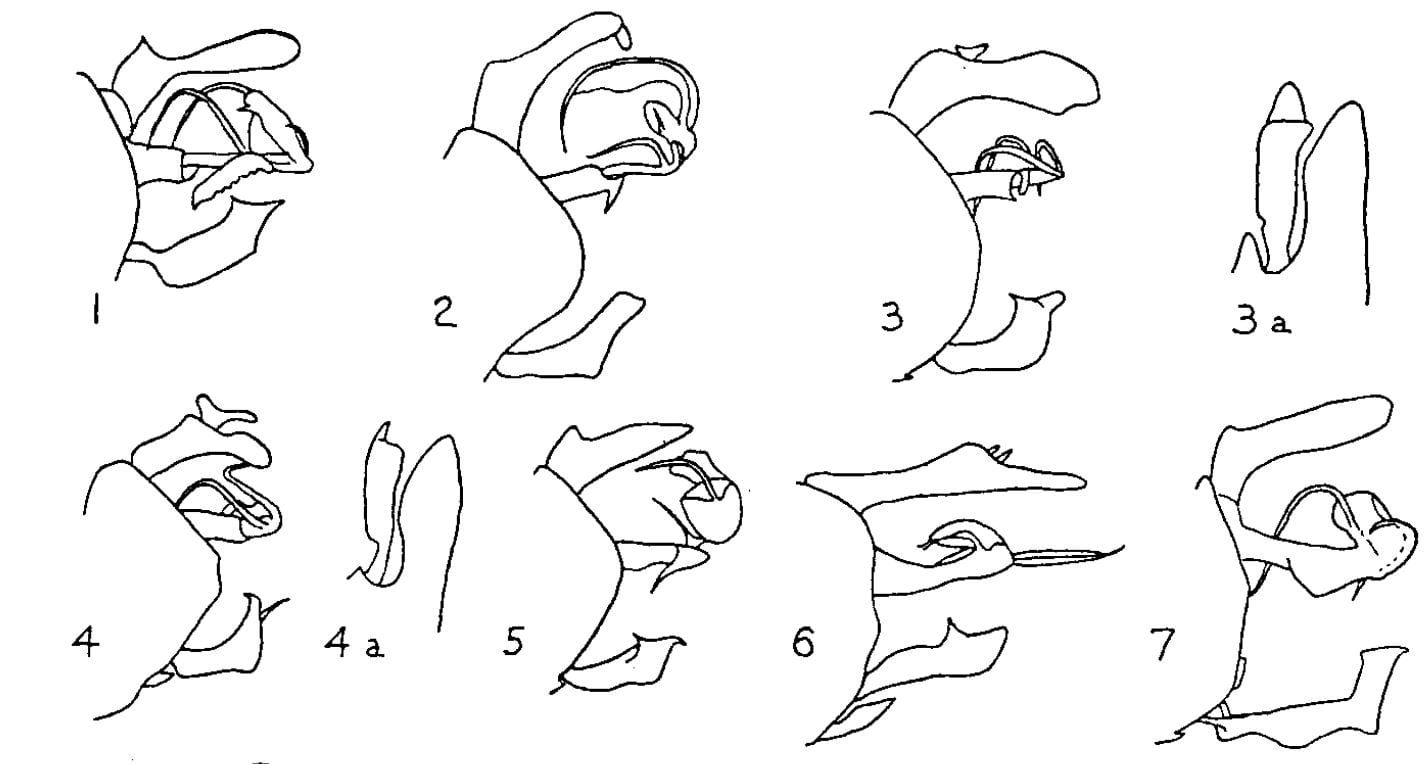
Bothriocera from Caldwell 1943. 1 B. tinealis, 2-3 westwoodi, 4 boliviensis, 5 signoreti, 6 metcalfi, 7 dampfi.
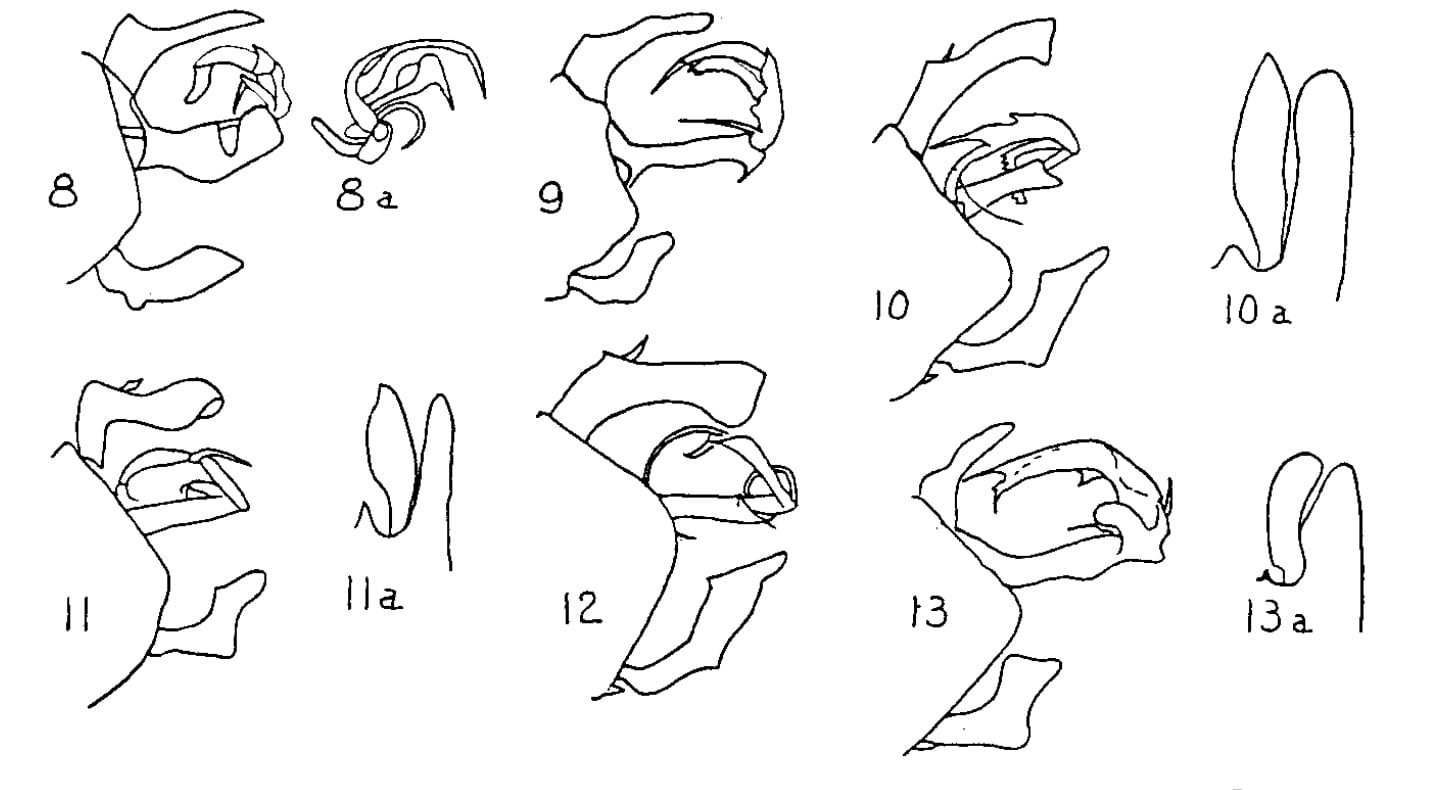
Bothriocera from Caldwell 1943. 8 transversa, 9 knulli, 10 furcata, 11 fasciola, 12 cognita, 13 undata.

Bothriocera sp. (Texas, Caddo Lake State Park, From BOLD)
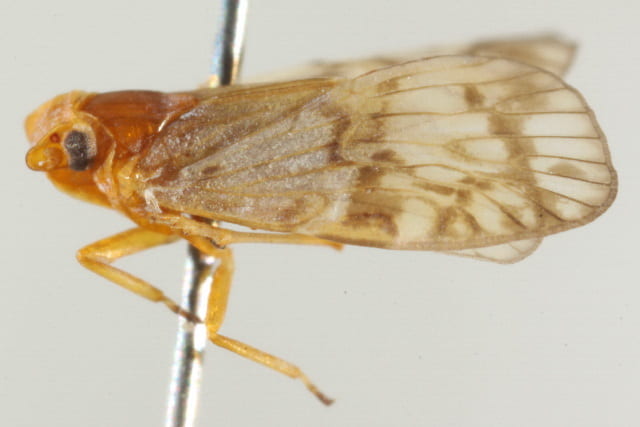
Bothriocera sp. (Florida, Collier Co., From BOLD)

Bothriocera sp. (Florida, Collier Co., From BOLD)
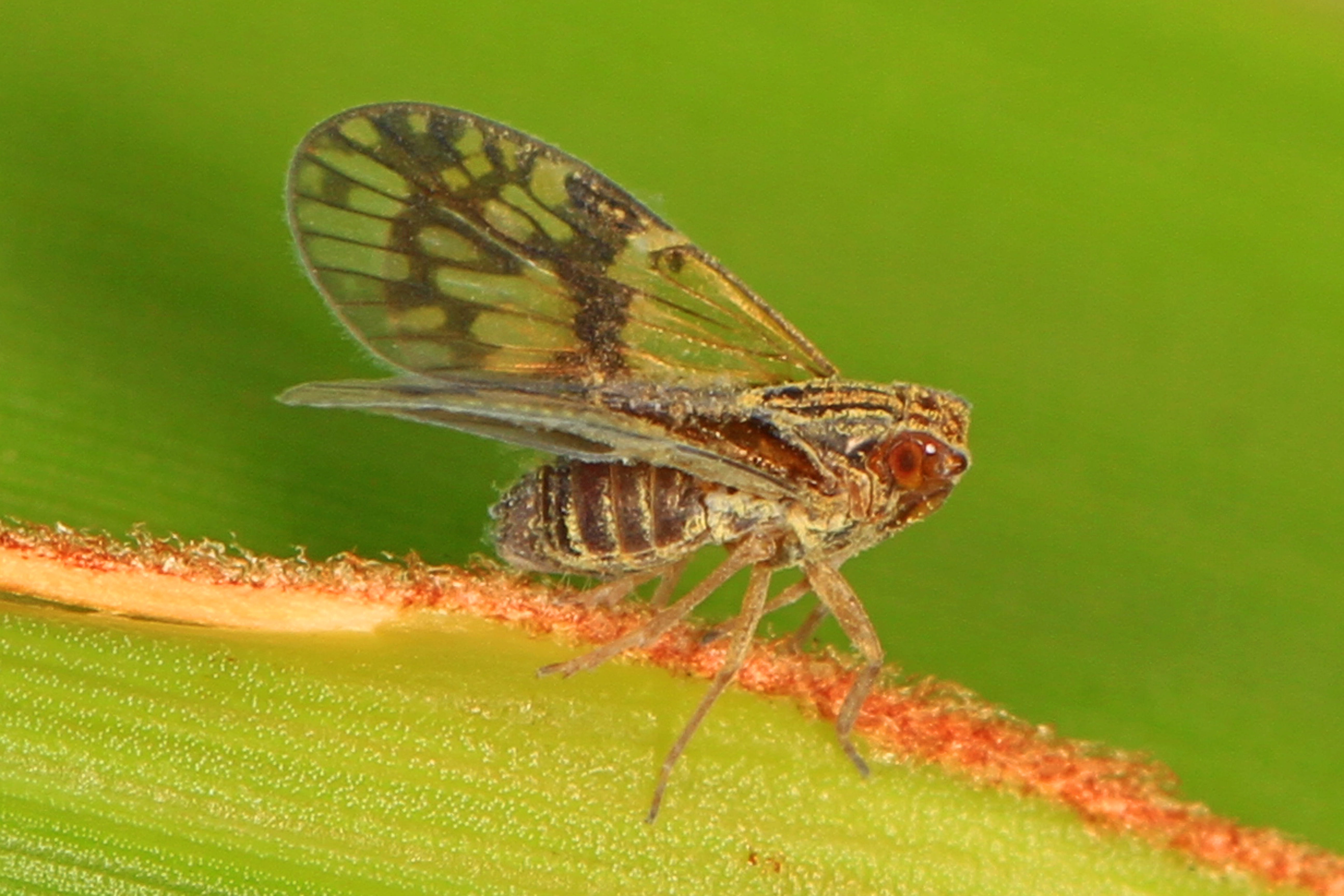
Bothriocera species, Okaloacoochee Slough State Forest, Felda, Florida, Judy Gallagher, Wiki Commons
Bothriocera sp. (Cixiidae), Caves Branch Jungle Lodge, Belmopan, Belize., Judy Gallagher, Wiki Commons
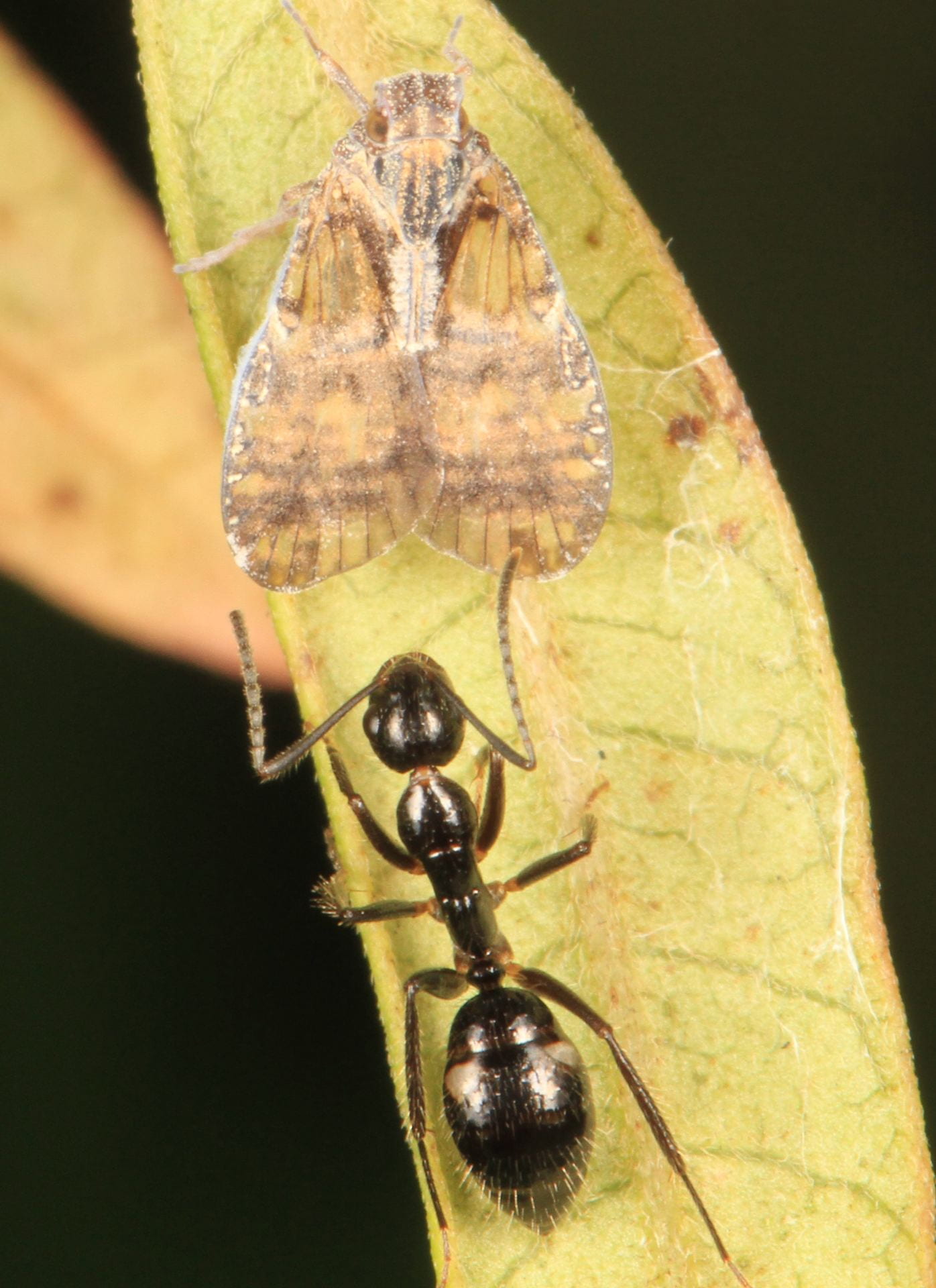
Bothriocera species and Ant – Camponotus sexguttatus, Pinelands, Everglades National Park, Homestead, Florida, Judy Gallagher, Wiki Commons
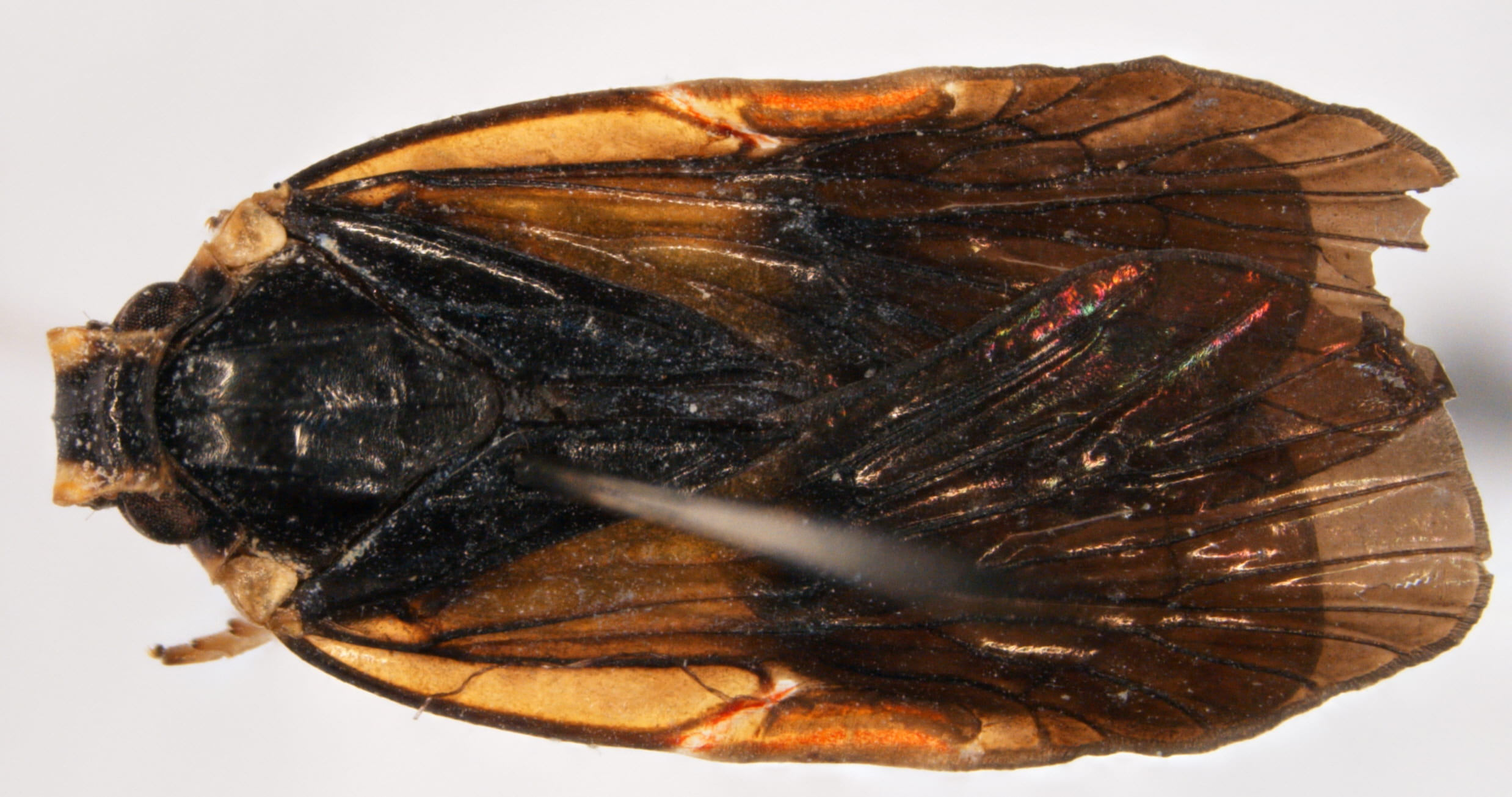
Bothriocera cf cyanea (GUADELOUPE; Basse-Terre; Capesterre-Belle-Eau; Basse-Terre, Capesterre-Belle-Eau, Chutes du Carbet; 16.05000, -61.56667; 03 Nov 2015; CP/EDM -Chloe Pierre)
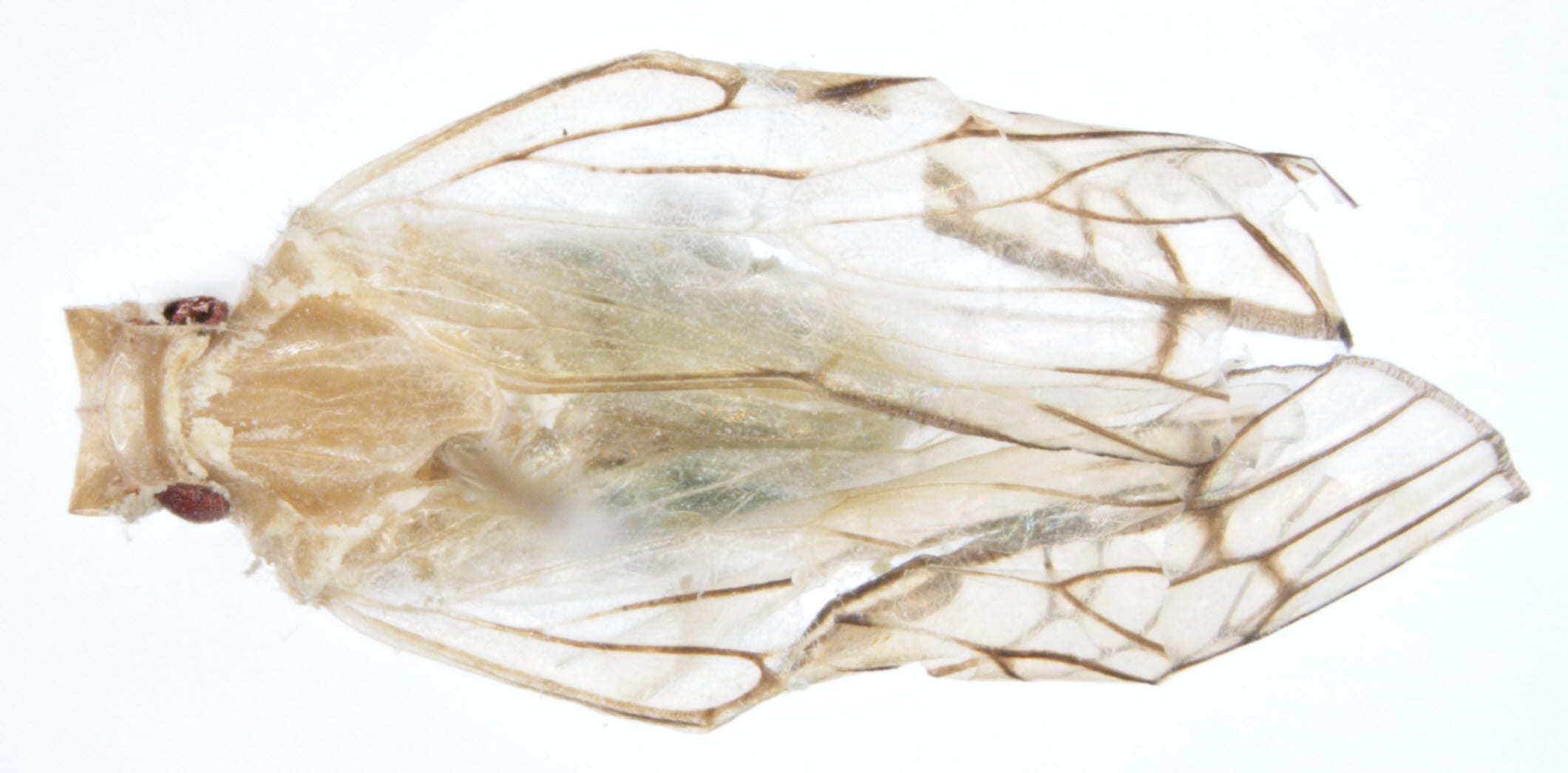
Bothriocera sp. (GUADELOUPE; Basse-Terre; Capesterre-Belle-Eau; Chutes du Carbet (Carbet Falls), Capesterre-Belle-Eau; 16.04480, -61.64879; 03 Nov 2015; CP/EDM -Chloe Pierre)
Online Resources
TaxonPages.
iNaturalist.
FLOW.
Bugguide.
EOL.
BOLD.
Hoppers of North Carolina.
An interesting species from Belize.
Collecting
Most often found sweeping plants in humid situations.
Molecular resources
As of this writing (May 2017), Barcode of Life has 13 specimens recorded to genus; Genbank has data for Bothriocera eborea and 2 undetermined Bothriocera spp.
Selected references
Bahder, B.W., W. Myrie, E.A. Helmick & C.R. Bartlett. 2023. A new species of planthopper in the genus Bothriocera (Hemiptera: Auchenorrhyncha: Cixiidae) from coconut palm (Cocos nucifera) in Jamaica. Zootaxa 5375(1): 111–127. https://doi.org/10.11646/zootaxa.5375.1.7.
Barrantes, E.A.B, M.A.Z. Echavarria, C.R. Bartlett, E.E. Helmick & B.W. Bahder. 2025. A new species of planthopper in the genus Bothriocera (Hemiptera: Auchenorrhyncha: Cixiidae) from Osa peninsula, Costa Rica on palms (Arecaceae). Zootaxa, 5613(3), 456–468. https://doi.org/10.11646/zootaxa.5613.3.2
Bartlett, C.R., L.B. O’Brien & S.W. Wilson. 2014. A review of the planthoppers (Hemiptera: Fulgoroidea) of the United States. Memoirs of the American Entomological Society 50: 1–287.
Burmeister, H.C.C. 1835a. Schnabelkerfe. Rhynchota. In: Handbuch der Entomologie. Gustav Reimer, overall work published 1832-1855. Berlin. 2 (1): 1–396.
Caldwell, J.S. 1943. Notes on the Genus Bothriocera Burmeister (Homoptera: Cixiidae). Lloydia 6: 318–325.
Caldwell, J.S. 1950. New genera and species of Cixiidae from Mexico. Proceedings of the Entomological Society of Washington 52: 287–290.
Caldwell, J.S. & L.F. Martorell. 1951 [dated 1950]. Review of the Auchenorynchous [sic] Homoptera of Puerto Rico. Part II. The Fulgoroidea except Kinnaridae. Journal of Agriculture of the University of Puerto Rico 34(2): 133–269.
Dozier, H.L. 1928 [dated 1922 or 1926]. The Fulgoridae or planthoppers of Mississippi, including those of possible occurrence. Technical Bulletin of the Mississippi Agricultural Experiment Station 14: 1–152.
Fabricius, J.C. 1798a. Ryngota. Os Rostro: Vagina articulata. Pp. 511-524. In Supplementum Entomologiae systematicae. Hafniae, Apud Proft et Storch.
Fabricius, J.C. 1803a. Rhyngota. In: Systema rhyngotorum: secundum ordines, genera, species: adiectis synonymis, locis, observationibus, descriptionibus. C. Reichard. Brunsvigae. Pp. 1–101.
Fennah, R.G. 1943. New species of Bothriocera Burm. (Homoptera: Cixiidae) from the Lesser Antilles. Psyche 50: 9–17.
Fennah, R.G. 1971. Fulgoroidea from the Cayman Islands and adjacent Areas. Journal of Natural History 5: 299–342.
Fowler, W.W. 1904. Order Rhynchota. Suborder Hemiptera-Homoptera. (Continued). Biologia Centrali-Americana 1:77-84.
Holzinger, W.E. 2004. A new replacement name for Vincentia Uhler, 1895 (non Castelnau, 1872) (Insecta: Hemiptera: Cixiidae). Revue Suisse de Zoologie. Annales de la Société Zoologique Suisse et du Muséum d’Histoire Naturelle de Genève. Genève 111(4): 951–952.
Holzinger, W.E., A.F. Emeljanov & I. Kammerlander. 2002. The family Cixiidae Spinola, 1839 (Hemiptera: Fulgoromorpha) – a Review. Denisia 4: 113–138.
Kramer, J.P. 1983. Taxonomic study of the planthopper family Cixiidae in the United States (Homoptera: Fulgoroidea). Transactions of the American Entomological Society 109: 1–57.
Lethierry, L.F. 1881. Liste des Hémiptères recueillis par M. Delauney à la Guadeloupe, la Martinique et Saint-Barthelemy. Annales de la Société entomologique de Belgique 25: 8–19.
Le Cesne, M., E. Huber & T. Bourgoin. 2025. Historical account and redescription of Bothriocera substigmatica (Lethierry, 1881) (Hemiptera, Fulgoromorpha, Cixiidae), an endemic species from the lesser Antilles. Zootaxa 5665. 85–98. https://doi.org/10.11646/zootaxa.5665.1.5.
Metcalf, Z.P. 1923a. A key to the Fulgoridae of Eastern North America with descriptions of new species. Journal of the Elisha Mitchell Scientific Society 38(3): 139–230, plus 32 plates. [from http://www.lib.unc.edu/dc/jncas/]
Metcalf, Z.P. 1936. General Catalogue of the Homoptera. Fascicle IV Fulgoroidea . Part 2 Cixiidae. Smith College, Northhampton, Massachusetts.
Metcalf, Z.P. 1938. The Fulgorina of Barro Colorado and other parts of Panama. Bulletin of the Museum of Comparative Zoology at Harvard College 83(5): 277–423.
Muir, F.A.G. 1923. On the classification of the Fulgoroidea (Homoptera). Proceedings of the Hawaiian Entomological Society 5: 205–247.
Myers, J.G. 1928. Notes on Cuban Fulgoroid Homoptera. Studies on Cuban Insects. 11-31 Harvard biological laboratory and botanical garden in Cuba, Cambridge, Mass.
O’Brien, L.B. 2006. Three new species of Neotropical Cixiidae (Hemiptera: Fulgoromorpha). Russian Entomological Journal 15(3): 311–314.
Schaum, H.R. 1850. Fulgorellae. In Allegemeine Encyklopädie der Wissenschaften und Kunste in alnhaberischen folge von Genannten Schriftstellern bearbeitet und herausgegeben von I.S. Ersch und I.G. Gruber mit Kupfern und Charten. Erster Section A-G. Vol. 51: 58–73.
Segarra-Carmona, A., R.A. Franqui, & M. Otero-Arocho. 2013. Survey of palm-associated Fulgoroidea in Puerto Rico. Journal of Agriculture of the University of Puerto Rico 97(3-4): 107–117.
Spinola, M. 1839. Essai sur les Fulgorelles, sous-tribu de la tribu des Cicadaires, ordre des Rhyngotes. Annales de la Société Entomologique de France 8: 133–337.
Stål, C. 1856. Hemiptera samlade af Victorin i Caplandet. Öfversigt af Kongliga Svenska Vetenskaps-Akademiens Förhandlingar 13: 193–199.
Stål, C. 1864. Hemiptera mexicana enumeravit speciesque novas descripsit. (Continuatio). Entomologische Zeitung 25: 49–86.
Thomas, M.C. 1989. Insect detection – a cixiid planthopper, Bothriocera datuna Kramer. Tri-Ology 28(3): 5.
Wilson, S.W., C. Mitter, R.F. Denno & M.R. Wilson. 1994. Evolutionary patterns of host plant use by delphacid planthoppers and their relatives. In: R. F. Denno and T. J. Perfect, (eds.). Planthoppers: Their Ecology and Management. Chapman and Hall, New York. Pp. 7–45 & Appendix

